Rosenmüllerhöhle
Rosenmüller Cave
Useful Information
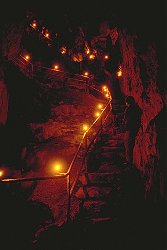
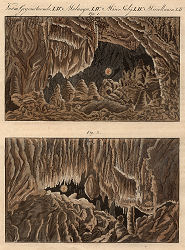
F. J. Bertuch (1805): Bilderbuch für Kinder, Verlag des Industrie-Comptoirs, Weimar, 1805.
Engraving, hand-coloured.
| Location: |
Schmiedsberg 19, 91346 Wiesenttal.
1,5 km north of Muggendorf, halfway towards Albertshof. From the road Muggendorf-Albertshof a trail starts to the Koppenburg, marked with a blue ring, which leads to the cave. (49.8080142, 11.2594066) |
| Open: |
MAY to OCT no restrictions. [2024] |
| Fee: |
free. [2024] |
| Classification: |
 Karst cave Karst cave
|
| Light: | bring torch, candles can be placed in candle holders at the railing |
| Dimension: | L=50 m, VR=12 m. |
| Guided tours: | self guide, L=64 m. |
| Photography: | allowed |
| Accessibility: | not wheelchair accessible, mainy steps |
| Bibliography: | |
| Address: |
Touristinformation Muggendorf, Forchheimer Str. 8, 91346 Wiesenttal, Tel: +49-9196-929931, Fax: +49-9196-929930.
E-mail: |
| As far as we know this information was accurate when it was published (see years in brackets), but may have changed since then. Please check rates and details directly with the companies in question if you need more recent info. |
|
History
| 1771 | first exploration of caves around Muggendorf by Johann Friedrich Esper. |
| 1774 | Johann Friedrich Esper publishes a book about the Muggendorfer Höhlen (Muggendorf caves). |
| 1775 | Johann Georg Wunder appointed and paid as cave guide and caretaker by Margrave Carl Alexander. |
| 18-OCT-1792 | first exploration by Johann Christian Rosenmüller from Jena, Johann Georg Wunder (*1725-✝1799) and his son Ludwig Wunder (*1771-✝1819) as local guides. |
| 1794 | first development as a show cave with wooden ladder and door, opend as a show cave in November. |
| 1795 | after a visit to Muggendorf, Johann Gottfried Köppel writes and publishes a 40-page description of various caves. |
| 1834 | visit by Prince Pückler-Muskau, after whom the Prince Pückler Ice was named. |
| 1836 | construction of an artificial entrance at the deepest point of the cave, construction of paths and stairs. |
| 1902 | first survey by A. Neischl and J. Reger. |
| 1962 | show cave closed after the trumpet was stolen. |
| 1999 | resurveyed and redrawn by A. Eichner, St. Hoffmann, R. Schoberth and Chr. Schöffel. |
Description
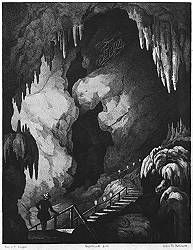
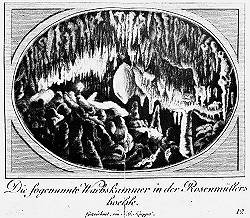
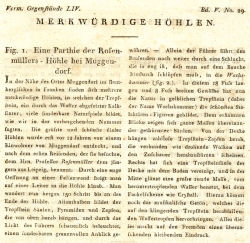
F. J. Bertuch (1805): Bilderbuch für Kinder, Verlag des Industrie-Comptoirs, Weimar, 1805.
Explanatory text to the engravings in German.
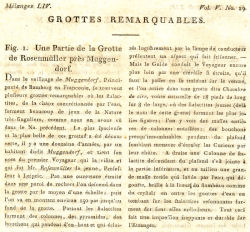
F. J. Bertuch (1805): Bilderbuch für Kinder, Verlag des Industrie-Comptoirs, Weimar, 1805.
Explanatory text to the engravings in French.
The Rosenmüllerhöhle (Rosenmüller's Cave) consists of a single huge chamber. The natural entrance is located under the ceiling of this room, so that the cave could only be entered with the appropriate equipment. How and when all this happened can no longer be traced today. In particular, there are two different discovery stories from the 1790s. In addition, every page on the internet seems to tell a different version. We have therefore decided to present a version that is reasonably well documented.
Johann Friedrich Esper began exploring the caves around Muggendorf in 1971 and published a book named Muggendorfer Höhlen about the Muggendorf Caves in 1774. After Esper's publications, scientific interest in the caves around Muggendorf grew. The Rosenmüller cave had been known to the people of Muggendorf for a long time, but it was impossible for common people to enter this vertical cave. So the hole in the ground was known only from the outside. There is a legend that the church authorities hid their treasures there during the Thirty Years' War. Whether this is true and how they did it can no longer be determined today. It is unlikely that they actually descended into the cave to do so, perhaps they simply lowered the treasure down with a rope and camouflaged the rope with stones. This allowed them to pull it up again later. However, this legend is rather unlikely.
The first documented exploration of the Rosenmüller Cave took place on 18 October 1792. And this is where the oddities begin, as Rosenmüller himself published the date 18 October 1793 in his 1804 description, but he had already published an exploration report in Jena six months before this date. It is therefore probably just a printing error in the year, but one that persists with extreme tenacity. The participants of this exploration were Johann Christian Rosenmüller from Jena, Johann Georg Wunder (*1725-✝1799) and his son Ludwig Wunder (*1771-✝1819) as local guides. According to one version of the story, the latter had discovered the cave two years earlier. Because of this first exploration, the cave was later called Rosenmüllerhöhle or Rosenmüller's Höhle. The cave chamber is 16 m high, and the entrance is at a height of 13 m. Most publications, including the one by himself, describe that the first person to enter was lowered down by the other two on a rope, presumably sitting on a piece of wood. It is not clear why several rope ladders tied together were used for the ascent. On the one hand, one could assume that the rope ladders could be used for the descent and ascent if they were already available. On the other hand, pulling a person up hardly seems more strenuous than lowering them down. It is obvious that no winch or pulley or anything similar was available.
The discovery of two human skeletons on the cone of rubble at the foot of the descent was a sensation. Apparently they had fallen down the shaft and died there. However, it could not be determined whether they were the victims of an accident, a murder or had been buried in the cave. What is certain is that they had probably been lying there for a long time. According to the old descriptions, they were partially covered in flowstone. However, the exact thickness of the flowstone, which would have given an indication of the minimum age, can no longer be determined. The bones were more or less complete, when discovered. But as always with humans, grasping comes from grasping, and so the bones were soon destroyed by the many visitors who touched them. As, according to the description, they lay directly under the opening, one or two people probably stepped on them as they descended. Another version says that they were removed, but nothing is known about their whereabouts.
It seems that the cave was known for a long time but had no use and was ignored. Ludwig Wunder probably discovered it in 1792 or a little earlier, but was unable to enter it. He lacked the equipment and the money to buy it. So he looked for a sponsor, which he found in Rosenmüller, who was the same age. He had begun his medical studies in Erlangen in the spring of 1792. Rosenmüller is always called an anatomy professor in Leipzig in later publications. But when he visited the cave, he was a freshman.
The development as a show cave began almost immediately. Rosenmüller informed the Royal Prussian Minister von Hardenberg almost immediately and suggested the development of the cave. He commissioned Wunder to obtain tenders and promised to bear the costs. He also sent a building inspector, Riedel, to examine the matter. After some back and forth, the king decided to finance the development. The decision was made in January, and the development was completed in November 1794.
When Johann Gottfried Köppel visited, the entrance was closed by a door and a ladder with 38 rungs was installed. Nevertheless, the visit was an adventure and there were probably a few near falls to report. Visitors miscalculated and thought they were already at the bottom and fell down the last part of the ladder. Köppel warned against this, but no one thought to simply count the rungs on the way down. It must have been really difficult, as visitors give different numbers, ranging from 28 to 42 rungs. Ludwig Wunder had the key to the cave and was also the cave guide. Using a long pole with arms as a chandelier and many candles, he lit up the cave on this occasion. Closure, ladder, lighting system and guide service - that fulfils the definition of a show cave. And Johann Georg Wunder was even an officially appointed Muggendorf cave keeper and cave guide. Ludwig Wunder became his successor in this position after his death. This makes it one of the first show caves in Germany.
Because the cave was so popular and the ladder posed a certain danger, as well as becoming increasingly dangerous due to the damp, maintenance was planned in 1829. However, the ladder became superfluous when an entrance tunnel was dug in 1836, leading into the cave from below. A path up the slope with stone steps and a railing was also built. The cave was obviously quite lucrative, and after the death of the last Wunder there was even a scramble for the successor. The successor, Johann Albrecht Häfner, wanted more visitors, especially women had problems with their clothes when climbing the ladder. In 1834, he therefore planned alternatives, but it proved too difficult to install a staircase. So finally, an 8-metre-long tunnel was built in 1836. This is another of the many misunderstandings, most publications state that it was built in 1830, but there was a misreading at some point and all later authors then copied the wrong number. Paths and railings were built in the steeply rising cave floor. The railings have candleholders at regular intervals, which provide atmospheric lighting for the cave.
The cave changed operators several times, but was probably open continuously as a show cave except during the Second World War. The cave's death knell was competition: the Devil's Cave and Bing's Cave were opened in the immediate vicinity, and visitor numbers fell rapidly until the cave was no longer profitable. After the war, it was renovated by the Muggendorf branch of the Franconian Switzerland Association and run on a voluntary basis. The planned electric lighting was never realized, the cave was operated with carbide lamps. It was then operated by the municipality of Muggendorf for a few more years, financed by the tourism budget. The last cave guide, Hans Wolf, used to announce the end of the last tour in the evening with a trumpet signal. In autumn 1962, the cave was broken into, and the trumpet stolen, and it was not reopened in 1963. It is not known whether the stolen trumpet was responsible for the closure. The cave guide became a lifeguard at the Muggendorf swimming pool.
This was followed by the most disgraceful period in the history of the cave. The door was left open for the next two decades, and the speleothems were almost completely stolen. Today, the cave has almost no stalactites at all. This is in stark contrast to the many exuberant descriptions of its former splendour. The historical engravings are all that is left. Nevertheless, the cave is freely accessible today and can be visited free of charge at any time, except during the bat protection period from November to April. You have to bring your own candles.
 Historic Show Caves
Historic Show Caves Search Google for "Rosenmüllerhöhle"
Search Google for "Rosenmüllerhöhle" Google Earth Placemark
Google Earth Placemark OpenStreetMap
OpenStreetMap Rosenmüller's cave (www.whonamedit.com)
Rosenmüller's cave (www.whonamedit.com)
 Index
Index Topics
Topics Hierarchical
Hierarchical Countries
Countries Maps
Maps Search
Search